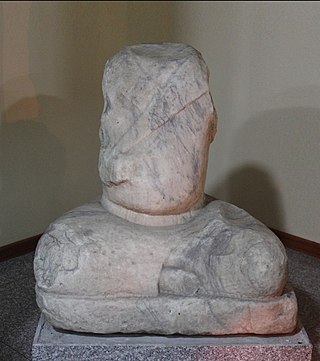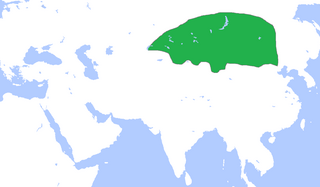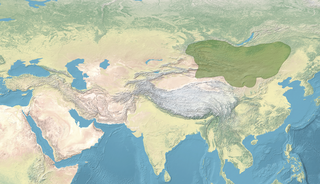Bumin Qaghan (Old Turkic: 𐰉𐰆𐰢𐰣:𐰴𐰍𐰣, romanized: Bumïn qaγan, also known as Illig Qaghan or Yamï Qaghan was the founder of the Turkic Khaganate. He was the eldest son of Ashina Tuwu. He was the chieftain of the Turks under the sovereignty of Rouran Khaganate. He is also mentioned as "Tumen" of the Rouran Khaganate.

Bilge Qaghan was the fourth Qaghan of the Second Turkic Khaganate. His accomplishments were described in the Orkhon inscriptions.
The Uyghur Khaganate was a Turkic empire that existed for about a century between the mid 8th and 9th centuries. They were a tribal confederation under the Orkhon Uyghur (回鶻) nobility, referred to by the Chinese as the Jiu Xing, a calque of the name Toquz Oghuz or Toquz Tughluq.

The Turkic migrations were the spread of Turkic tribes and Turkic languages across Eurasia between the 6th and 11th centuries. In the 6th century, the Göktürks overthrew the Rouran Khaganate in what is now Mongolia and expanded in all directions, spreading Turkic culture throughout the Eurasian steppes. Although Göktürk empires came to an end in the 8th century, they were succeeded by numerous Turkic empires such as the Uyghur Khaganate, Kara-Khanid Khanate, Khazars, and the Cumans. Some Turks eventually settled down into sedentary societies such as the Qocho and Ganzhou Uyghurs. The Seljuq dynasty settled in Anatolia starting in the 11th century, resulting in permanent Turkic settlement and presence there. Modern nations with large Turkic populations include Kyrgyzstan, Turkmenistan, Turkey, Azerbaijan, Uzbekistan and Kazakhstan, and Turkic populations also exist within other nations, such as Chuvashia, Bashkortostan, Tatarstan, the Crimean Tatars, the Kazakhs in Mongolia, the Uyghurs in China, the Azeri in Iran, and the Sakha Republic in Siberia.

The Toquz Oghuz was a political alliance of nine Turkic Tiele tribes in Inner Asia, during the early Middle Ages. The Toquz Oghuz was consolidated and subordinated within the First Turkic Khaganate (552–743) and remained as a nine-tribe alliance after the Khaganate fragmented.

The Xueyantuo were an ancient Tiele tribe and khaganate in Northeast Asia who were at one point vassals of the Göktürks, later aligning with the Tang dynasty against the Eastern Göktürks.

The Shatuo, or the Shatuo Turks were a Turkic tribe that heavily influenced northern Chinese politics from the late ninth century through the tenth century. They are noted for founding three, Later Tang, Later Jin, and Later Han, of the five dynasties and one, Northern Han, of the ten kingdoms during the Five Dynasties and Ten Kingdoms period. The Northern Han would later be conquered by the Song dynasty. Sometime before the 12th century, the Shatuo disappeared as a distinct ethnic group, many of them having become acculturated and assimilating into the general population around them.

The Eastern Turkic Khaganate was a Turkic khaganate formed as a result of the internecine wars in the beginning of the 7th century after the First Turkic Khaganate had splintered into two polities – one in the east and the other in the west. Finally, the Eastern Turkic Khaganate was defeated and absorbed by the Tang dynasty, and Xueyantuo occupied the territory of the former Turkic Khaganate.

The Tang campaign against the Eastern Turks of 629-630 was an armed conflict that resulted in the Tang dynasty destroying the Eastern Turkic Khaganate and annexing its territories.
Li Guangyan (761–826), courtesy name Guangyuan (光遠), né Ädiz Guangyan (阿跌光顏), was a Chinese military general and politician of Tiele ethnicity who served under the Tang dynasty. He was known for his participation in various campaigns against regional warlords during the reigns of Emperor Xianzong and Emperor Muzong.

The Tiele, also transliterated as Dili, Chile, Zhile, Tele, also named Gaoche or Gaoju, were a tribal confederation of Turkic ethnic origins living to the north of China proper and in Central Asia, emerging after the disintegration of the confederacy of the Xiongnu. Chinese sources associate them with the earlier Dingling.
Li Sizhong (李思忠), né Ormizt (嗢沒斯), formally the Prince of Huaihua (懷化王), was a general of the Chinese Tang Dynasty of Huigu ancestry, who submitted to Emperor Wuzong after the collapse of the Huigu Khaganate in 840 and subsequently served the Tang imperial government.
The history of the Uyghur people extends over more than two millenia and can be divided into four distinct phases: Pre-Imperial, Imperial, Idiqut, and Mongol, with perhaps a fifth modern phase running from the death of the Silk Road in AD 1600 until the present.

The Second Turkic Khaganate. was a khaganate in Central and Eastern Asia founded by Ashina clan of the Göktürks that lasted between 682–744. It was preceded by the Eastern Turkic Khaganate (552–630) and the early Tang dynasty period (630–682). The Second Khaganate was centered on Ötüken in the upper reaches of the Orkhon River. It was succeeded by its subject Toquz Oghuz confederation, which became the Uyghur Khaganate.
Kutlug I Bilge Boyla Khagan, also known by his throne name Qutlugh Bilge Kül Qaghan, and in Chinese sources the personal name of Yaoluoge Yibiaobi (藥羅葛逸标苾) was the Khagan of Uyghur Khaganate, the successor state of the Second Turkic Khaganate, from 744 to 747 AD.
Alp Bilge Qağan or Eletmiş Qağan — was a Basmyl chief who rebelled and brought Second Turkic Khaganate to an end.

The Yaglakar clan was the first imperial clan of the Uyghur Khaganate. Descendants of the Yaglakar clan would later establish the Ganzhou Uyghur Kingdom.
Tun Baga Tarkhan or Alp Qutlugh Bilge Qaghan — was the fourth leader of Uyghur Khaganate.
Qutluq Bilge Qaghan was the sixth khagan of the Uyghur Khaganate and the last one from the Yaglakar clan. His Tang invested title was Fengcheng Qaghan.
Alp Qutluq Külüg Bilge Qaghan — seventh khagan of the Uyghur Khaganate and the first one from the Ädiz clan. His Tang invested title was Huaixin Qaghan.






